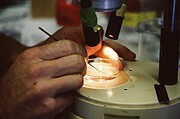
FRIDAY, Aug. 29, 2014 (HealthDay News) — The main strain of a common antibiotic-resistant infection in Europe, the Middle East and North Africa originated in sub-Saharan Africa, a new study says.
Researchers studied so-called community-acquired methicillin-resistant Staphylococcus aureus (CA-MRSA) infections, which occur in healthy people who have not recently been hospitalized. These infections typically affect the skin and can be transmitted through person-to-person contact or through touching contaminated objects such as clothing or towels.
The predominant strain of CA-MRSA in Europe is called CC80. It was identified in the late 1990s, and has since been detected throughout the Middle East and North Africa. There also have been sporadic reports of the strain in Asia, Australia and South America, the study authors noted.
The researchers analyzed samples of CC80 from 22 countries in Asia, North and sub-Saharan Africa, Europe and the Middle East, and found that it originated from a single sub-Saharan ancestor.
The CC80 strain likely started to spread from sub-Saharan Africa to other regions starting in the mid-1980s because of increased migration of people from sub-Saharan Africa to other countries and growth in the number of European tourists traveling to this part of Africa, according to the researchers.
The study was published Aug. 26 in the online journal mBio.
“With increasing levels of CA-MRSA reported from most parts of the Western world, there is a great interest in understanding the origin and factors associated with the emergence of these epidemic lineages,” lead author Marc Stegger, of the microbiology and infection control department at Statens Serum Institute in Denmark, said in a news release from the American Society for Microbiology.
“Our study determined that a single descendant of a methicillin-sensitive ancestor circulating in sub-Saharan Africa rose to become the dominant CA-MRSA clone in Europe, the Middle East and North Africa,” Stegger said.
More information
The U.S. National Library of Medicine has more about MRSA.
Copyright © 2024 HealthDay. All rights reserved.

